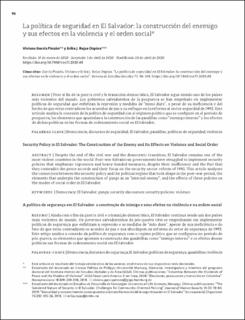| dc.contributor.author | Rojas Ospina, Erika Julieta | |
| dc.contributor.author | García Pinzón, Viviana | |
| dc.date.accessioned | 2020-12-01T15:02:27Z | |
| dc.date.available | 2020-12-01T15:02:27Z | |
| dc.date.created | 2020-11-18T10:21:08Z | |
| dc.date.issued | 2020 | |
| dc.identifier.citation | Revista de Estudios Sociales. 2020, (73), 98-108. | en_US |
| dc.identifier.issn | 1900-5180 | |
| dc.identifier.uri | https://hdl.handle.net/11250/2711281 | |
| dc.description.abstract | Despite the end of the civil war and the democratic transition, El Salvador remains one of the most violent countries in the world. Post-war Salvadoran governments have struggled to implement security policies that emphasize repression and heavy-handed measures, despite their inefficiency and the fact that they contradict the peace accords and their focus on the security sector reform of 1992. This article analyses the connection between the security policy and the political regime that took shape in the post-war period, the elements that underpin the construction of gangs as an “internal enemy”, and the effects of these policies on the modes of social order in El Salvador. | en_US |
| dc.language.iso | spa | en_US |
| dc.rights | Attribution-NonCommercial-NoDerivatives 4.0 Internasjonal | * |
| dc.rights.uri | http://creativecommons.org/licenses/by-nc-nd/4.0/deed.no | * |
| dc.title | Security Policy in El Salvador: The Construction of the Enemy and Its Effects on Violence and Social Order | en_US |
| dc.type | Journal article | en_US |
| dc.description.version | publishedVersion | en_US |
| dc.source.pagenumber | 98-108 | en_US |
| dc.source.journal | Revista de Estudios Sociales | en_US |
| dc.source.issue | 73 | en_US |
| dc.identifier.doi | https://doi.org/10.7440/res73.2020.08 | |
| dc.identifier.cristin | 1849109 | |
| cristin.ispublished | true | |
| cristin.fulltext | original | |

